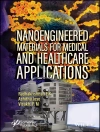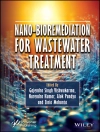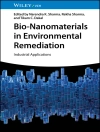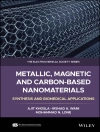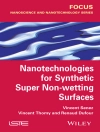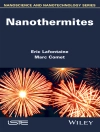Students at universities the world over will benefit from the authors’ concise treatment, arising out of lectures given for a graduate and advanced undergraduate course at Penn State University (USA) and University of Technology Delft (NL).
The textbook begins by addressing, in general terms, the phenomena and peculiarities that occur at the nanoscale. In the following five chapters, readers are introduced in detail to nanoscale physics, chemistry, materials science, and biology, followed by chapters on synthesis and fabrication as well as characterization at the nanoscale. In the next four chapters a variety of exemplary applications taken from a wide range of sectors are also presented and discussed. Concerns for safety, environmental impact, workforce development, economic wellbeing, and societal change issues arising from nanotechnology are woven throughout the book and additionally form the focus of the last two chapters.
विषयसूची
Preface xiii
Acknowledgment xv
1 Nanotechnology:What, Why, and Why Now? 1
1.1 What Is Nanotechnology? 1
1.2 Why Is Nanotechnology So Unique? 3
1.3 Where Did Nanotechnology Come From? 11
1.4 Why Has Nanotechnology Burst Forth Now? 12
2 Some Physics Fundamentals Pertinent to Nanotechnology 15
2.1 Introduction 15
2.2 Some Pertinent Physics Fundamentals 15
2.2.1 Energy Quantization 15
2.2.2 Wave–Particle Duality 17
2.2.3 Particles and Waves 17
2.2.3.1 Electrons and Probability Waves 19
2.2.3.2 Photons and E-MWaves 22
2.2.4 Some Further Aspects of Quantum Mechanics 25
2.2.4.1 Tunneling 25
2.2.4.2 Uncertainty 27
2.2.4.3 Quantum Fluctuations 27
2.2.4.4 Entanglement 28
2.2.5 Statistics and Thermodynamics 29
2.2.5.1 Statistical Mechanics 29
2.2.5.2 Thermal Fluctuations 33
3 Some Chemistry Fundamentals Pertinent to Nanotechnology 35
3.1 Introduction 35
3.2 Some Pertinent Chemistry Fundamentals 35
3.2.1 The Single Electron Atom 35
3.2.2 Multielectron Atoms 39
3.2.3 Nanoparticles 40
3.2.3.1 Functionalized Nanoparticles 40
3.2.3.2 Nanoparticle Assembly 41
3.2.4 Chemical Bonding of Atoms, Molecules, and Nanoparticles 41
3.2.4.1 Covalent Bonding 41
3.2.4.2 ???? Stacking 42
3.2.4.3 Ionic Bonding 43
3.2.4.4 Metallic Bonding 43
3.2.4.5 Permanent Dipole Bonding 43
3.2.4.6 Fluctuating Dipole Bonding 44
3.2.4.7 Philicity and Phobicity Interactions 44
3.3 Supramolecular Chemistry 45
3.4 Quantum Chemistry 45
4 Some Biology and Biochemistry Fundamentals Pertinent to Nanotechnology 49
4.1 Introduction 49
4.2 Some Pertinent Biology and Biochemistry Fundamentals 49
4.2.1 Cells, Biomolecules, and Machinery 49
4.2.2 The Molecules of Life 52
4.2.2.1 Carbohydrates 52
4.2.2.2 Lipids 55
4.2.2.3 Nucleic Acids 55
4.2.2.4 Proteins 57
4.3 Viruses 57
4.4 Microbes, Molecules, and Nanomaterials 57
4.5 Applying Biology to Nanotechnology Systems 58
5 Some Materials Science Fundamentals Pertinent to Nanotechnology 59
5.1 Introduction 59
5.2 Some Materials Fundamentals 59
5.2.1 Structure of a Solid 59
5.2.2 Quantum State of a Solid 61
5.2.2.1 Valence Electron states in a 3-D Solid 62
5.2.2.2 Vibration Modes in a 3-D Solid 68
5.2.2.3 Valence Electron States in 2-D Solids 69
5.2.2.4 Vibration Modes in 2-D Solids 72
5.2.2.5 Valence Electron States in 1-D Materials 72
5.2.2.6 Vibration Modes in 1-D Materials 73
5.2.2.7 Valence Electron States in 0-D Materials 76
5.2.2.8 Vibration Modes in 0-D Materials 77
5.2.2.9 Topological Materials 77
5.2.3 Spin and Orbital Angular Magnetic Moment in Solids 79
6 Properties of Nanotechnology Materials 81
6.1 Introduction 81
6.2 Material Properties and the Nanoscale 81
6.2.1 Electrical Conduction Properties of Nanomaterials 81
6.2.2 Optical Properties of Nanomaterials 84
6.2.3 Magnetic Properties of Nanomaterials 88
6.2.4 Catalytic Properties 89
6.2.5 Thermal and Thermoelectric Properties 89
6.2.6 Mechanical Properties 92
7 An Overview of Nanotechnology Characterization Approaches 95
7.1 Introduction 95
7.2 Visible Range Light: Optical Microscopy 96
7.3 Probe Nanocharacterization Methods 98
7.3.1 Probe Microscopies 99
7.3.1.1 Atomic Force Microscopy (AFM) 99
7.3.1.2 Electrostatic Force Microscopy (EFM) 103
7.3.1.3 Magnetic Force Microscopy (MFM) 103
7.3.1.4 Kelvin Probe Force Microscope (KPFM) 103
7.3.1.5 Scanning Tunneling Microscopy (STM) 104
7.3.2 Probe Spectroscopies 104
7.3.2.1 Scanning Tunneling Spectroscopy (STS) 105
7.3.2.2 Tip-Enhanced Raman Spectroscopy (TERS) 105
7.4 Further E-M Radiation-Based Nanoscale Characterization Methods 106
7.4.1 Nonvisible E-M Radiation Microscopies 106
7.4.2 E-M Radiation-Driven Spectroscopies 106
7.4.2.1 X-ray Diffraction (XRD) 106
7.4.2.2 Small Angle X-ray Scattering (SAXS) 107
7.4.2.3 Photoelectron Spectroscopies 108
7.4.2.4 Infrared Spectroscopy 109
7.4.2.5 Raman Spectroscopies 109
7.4.2.6 E-M Radiation Driven Mass Spectroscopy 110
7.5 Electron Beam Nanocharacterization Methods 110
7.5.1 Electron Beam Microscopies 110
7.5.1.1 Transmission Electron Microscopy 112
7.5.1.2 Scanning Electron Microscopy 113
7.5.1.3 Scanning Auger Microscopy (SAM) 113
7.5.2 Electron-Beam-Based Spectroscopies 114
7.5.2.1 Characteristic X-ray Emission Spectroscopies 114
7.5.2.2 Auger Electron Spectroscopy (AES) 114
7.5.2.3 Electron Energy Loss Spectroscopy (EELS) 115
7.5.2.4 Low- and High-Energy Electron Diffraction 115
7.6 Ion Beam Nanocharacterization Techniques 116
7.6.1 Ion Beam Microscopy 116
7.6.1.1 Scanning Helium Ion Microscopy (SHIM) 116
7.6.1.2 Atom Probe Field Ion Microscope (AP-FIM) 117
7.6.2 Ion Beam Driven Spectroscopies 118
7.6.2.1 Secondary Ion Mass Spectroscopy (SIMS) 118
7.6.2.2 Low-Energy Ion Scattering (LEIS) 118
7.7 Neutral Particle Beam Nanocharacterization Techniques 119
8 Nanomaterial Preparation and Device Fabrication: Nonbiological Approaches 121
8.1 Introduction 121
8.2 Materials Preparation 121
8.2.1 Physical Preparation Methods 121
8.2.1.1 Milling Processes 122
8.2.1.2 Physical Vapor Deposition Processes 123
8.2.1.3 Physical Ion Beam Processing 124
8.2.1.4 Langmuir–Blodgett Deposition 125
8.2.1.5 Probe Deposition 125
8.2.1.6 Electrospinning 125
8.2.2 Chemical Preparation Methods 127
8.2.2.1 Colloidal Chemistry 127
8.2.2.2 Sol–Gel Processing 129
8.2.2.3 Surfactant Self-Assemblies: Micelles and Microemulsions Processing 129
8.2.2.4 Structured Polymers Processing 130
8.2.2.5 Nanocomposite Formation 132
8.2.2.6 Chemical Vapor Deposition Processes 133
8.2.2.7 Epitaxial Growth Techniques 135
8.2.2.8 Focused Ion Beam Deposition 136
8.3 Fabrication 136
8.3.1 Pattern Orchestration 136
8.3.2 Etching 138
8.3.3 Process Flow 139
9 Nanomaterial Preparation and Device Fabrication: Biologically Based Approaches 141
9.1 Introduction 141
9.2 Biologically Based Materials Preparation 141
9.2.1 Nanomaterial Biosynthesis Using Plant Substances 141
9.2.2 Material Biosynthesis Using Eukaryotic Cells 142
9.2.3 Material Biosynthesis Using Prokaryotic Cells 142
9.2.4 Nanomaterial Biosynthesis Using Viruses 143
9.2.5 Nanomaterials Biosynthesis Using Amino Acids, Peptides, and Proteins 144
9.3 Biologically Based Fabrication – Bionanofabrication 146
9.3.1 Bionanofabrication Using Cell Structures 146
9.3.2 Bionanofabrication Using Viruses 147
9.3.3 Bionanofabrication Using DNA 147
9.3.4 Bionanofabrication Using Proteins 148
9.3.5 Bionanofabrication Using Peptides 149
10 Nanotechnology and Engineering: Computing, Communications, Imaging, and Sensing 151
10.1 Introduction 151
10.2 Nanoelectronics 152
10.3 Spintronics 153
10.4 Nanophotonics 156
10.5 Nano-Optoelectronics 156
10.6 Sensors 158
11 Nanotechnology and Engineering: Materials, Energy Technologies, the Environment, Food and Agriculture, and Chemical Processes 159
11.1 Introduction 159
11.2 Some Basic Materials 159
11.3 Textile Materials 162
11.4 Energy Technology 163
11.4.1 Super-Capacitor Energy Conversion 164
11.4.2 Chemical Energy Conversion Technology 165
11.4.2.1 Batteries 165
11.4.2.2 Fuel Cells 166
11.4.3 Photovoltaic Energy Conversion 167
11.4.4 Hydrogen Storage 167
11.5 Environmental Engineering 168
11.6 Food and Agriculture 169
11.7 Chemical Processing 170
12 Nanotechnology and Medicine: NP Targeting for Therapy and Imaging 173
12.1 Introduction 173
12.2 Some Current and Future Targeting Therapy and Imaging Opportunities 175
12.2.1 NP Targeting for Cancer 175
12.2.2 NP Targeting for Cardiovascular Diseases 180
12.2.3 NP Targeting for Pulmonary Diseases or Infections 184
12.2.4 NP Targeting for Neurological Disorders 186
13 Nanotechnology and Medicine: Devices and Materials 189
13.1 Introduction 189
13.2 Some Current and Future Devices and Materials 189
13.2.1 Devices 189
13.2.1.1 Nanoelectronics and Nanosensors 190
13.2.1.2 Nanomechanical Devices 192
13.2.1.3 Lab-on-a-Chip Devices 193
13.2.2 Materials 194
13.2.2.1 Scaffolds for Tissue Growth 194
13.2.2.2 Injectable and Implantable Materials 195
13.2.2.3 Stents 196
14 Nanotechnology: The Risks 199
14.1 Introduction 199
14.2 Key Factors Influencing Nanomaterial Toxicity 201
14.3 NP Entry Routes and Some Possible Resulting Diseases 203
14.3.1 Entry by Inhalation 204
14.3.2 Entry by Contact 205
14.3.3 Entry by Ingestion 205
14.4 Nanoparticle Clearance Routes 205
14.5 Nanoparticle Translocation through Biological Barriers 207
14.6 Overall Effects of Nanoparticles 208
14.7 Nanotoxicology 209
14.7.1 In vivo Models 209
14.7.1.1 Inhalation Approach 209
14.7.1.2 “Nose – Only” Approach 209
14.7.1.3 Intra-Tracheal Instillation Approach 210
14.7.1.4 Feed/Gavage Approach 210
14.7.1.5 Cutaneous Contact Approach 210
14.7.1.6 Injection Approach 210
14.7.2 In vitro Models 210
14.8 Nanotoxicology Limitations 211
15 Nanotechnology: Economic, Environmental, Societal, and Health Impact 213
15.1 Introduction 213
15.2 Nanotechnology and the Economy 214
15.3 Nanotechnology and the Environment 215
15.4 Nanotechnology and Society 217
15.4.1 Public Engagement and Consumer Acceptance 217
15.4.2 Nanotechnology and Ethics 218
15.5 Nanotechnology and Health 219
15.5.1 Regulatory Aspects 220
15.5.2 Workplace and Consumer Protection 220
15.5.3 Labeling Requirements 222
15.6 Summary 222
A Canonical Ensemble Statistics 223
B Fermi–Dirac Statistics 227
C Bose–Einstein Statistics 231
References 233
Index 267
लेखक के बारे में
Stephen Fonash is Chaired Professor of Engineering Sciences at Penn State University, USA. During his academic career he received numerous honors and awards, including a fellowship of the Electrochemical Society and the Thomas D. Callinan Award for outstanding contributions to dielectric science and technology. He is also Director of the National Science Foundation Nanotechnology Applications and Career Knowledge Center, Founder and Director of the Penn State Center for Nanotechnology Education and Utilization, and co-founder and chief technical officer of Solarity, LLC, State College, PA.
Marcel Van de Voorde is special advisor at IMEC, Belgium. He studied industrial and chemical engineering and received his Ph D in nuclear engineering from the University of Nancy, France. He was co-founder and professor at the Hoger Instituut der Kempen, Geel, and the Technical Institute Don Bosco, Hoboken in Belgium. He further holds professorships at the Catholic University of Leuven, Ghent University, Delft University of Technology and is visiting professor at several recognized universities in Europe, US, Japan and China.


